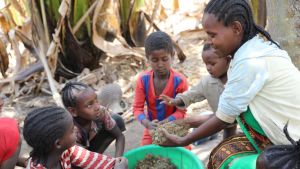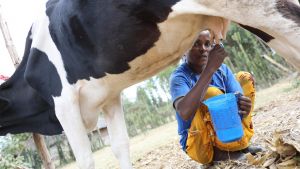The Gendered Impacts of Integrated Pest Management in Ethiopia and Beyond

Integrated pest management benefits the environment, farmers' productivity, and time-strapped women around the world.
In a rural community within Hawassa, Ethiopia, you can find farmers like Mariam Bagune.
Bagune not only cultivates maize in Mekbasa Korkie village, but she also manages her family’s livestock and is a mother of four. With childcare, animal care, and crop care all at the top of Bagune’s list of responsibilities, time is something she cannot afford to waste. Even so, the conventional agricultural techniques she relies on can be labor intensive and sometimes lead to low productivity.
After adopting the Push-Pull Technology, Bagune and many families like hers are finally starting to address those constraints.
Push-Pull, introduced to 17 villages in East Africa through a partnership between the Feed the Future Innovation Lab for Integrated Pest Management (IPM IL) and the International Centre of Insect Physiology and Ecology (ICIPE), is a crop systems-based farming method named for its ability to “push” or repel and “pull” or trap yield-threatening pests.
The strategy involves intercropping maize with grasses such as Desmodium, which repels—pushes away—the destructive stemborer pest. Desmodium also inhibits the growth of the invasive Striga weed and naturally adds beneficial nitrogen to soil. Simultaneously, planting an attractant plant-like Napier grass or Brachiaria around the border of this intercrop traps – pulls in – pests before they enter the field, thus protecting the food crop double-fold. Brachiaria and Napier are also both perennial, which encourages the conservation of soil moisture and improves long-term soil health.
Significantly improved crop yields—up to four times more maize—and reduced reliance on synthetic chemical pesticides are major benefits of Push-Pull, but the farming strategy has also led to livestock benefits felt especially by Bagune and other women farmers.
Since Bagune began implementing Push-Pull in her family’s maize fields in 2019, milk production has doubled. The plants involved in Push-Pull are all considered high-quality animal fodder plants, so after they do the work of protecting maize from pests, they can be fed to livestock, improving the quality of milk and milk products cows produce.
“I received training by ICIPE, convinced my family and implemented the technology,” said Bagune. “Together with my husband, we engaged in fattening and dairy production. We feed our cattle Desmodium and Brachiaria in combination and get remarkable yields, 7000 ETB [USD $175] from the sales.”
Bagune is also a leader in her village—since experiencing benefits from Push-Pull, she has begun voicing and sharing her knowledge about the farming strategy with other community members to increase adoption.

Mariame Bagune shows her family Brachiaria seeds.
 Play Video
Play Video
Fantu Ergato milks one of her cows. She has seen a significant increase in quality and quantity of her milk since practicing Push-Pull.
Women face a disproportionate burden
Nearly 40 percent of women in Ethiopia work in agriculture and bear a disproportionate burden of the workload, observing a number of simultaneous duties including food preparation, fetching water, hand-weeding, selling milk and milk products, livestock fattening, and more. Even so, women’s labor often goes unrecognized, which contributes to a lack of access to and control over valuable resources, including on-farm decision-making, land ownership, and extension services. This limited access to resources and information is exacerbated by women’s limited time to contribute to such activities.
With time constraints limiting opportunities for women to engage in income-generating opportunities that might otherwise give access to resources to invest in reducing their agricultural labor burdens, it is vital that the introduction of new agricultural technologies engage women without compromising their other responsibilities or the needs of the local community.
Push-Pull opens up possibilities for increased engagement and leadership of women more generally in on-farm activities. More so, it shows major potential for saving time and generating additional income around activities typically observed by women in Ethiopia—for instance, dairy production and hand-weeding—while also tackling pests, weeds, poor soil conditions, and other constraints farmers face every day.
Take, for example, Almaz Mute, a woman living not far from Bagune in Jara Gelelcha village, Ethiopia. Since implementing Push-Pull, she has been able to sell more milk, as her cows’ milk production has increased from 1 liter per cow per day to 2 liters, and she is also beginning to save money in unexpected ways.
“Since 2016, we are enjoying the benefits of Push-Pull Technology,” Mute said, “these include producing pest-free maize and improving livestock feed. This area [Hawassa] is highly affected by forage scarcity. We used to purchase fodder from long distance, which had a transportation expense burden. All these problems became history because of the Push-Pull. You can see the Push-Pull companion grasses (Desmodium and Brachiaria) are even green during this dry season.”
Fantu Ergato, Mute’s neighbor, said that there is a significant difference in the quality and quantity of milk production between the Push-Pull-adopting farmers and non-technology adopters in her village and that due to Desmodium’s and Brachiaria’s palatability for the dairy cattle, there are also significant improvements in the quality of the butter they make, sell, and consume. While Ergato’s family used to rely solely on crop farming, Push-Pull helped them to diversify their means of income.
“The Push-Pull technology is very convenient for us, particularly in reducing stem borers and improving livestock feed,” said Ergato. “I also had no cattle before the project because of the scarcity of feed. Following the introduction of Push-Pull, we started to raise dairy husbandry. Now we have two dairy cows producing quality milk, one bull, and two calves. This is an effect of the Push-Pull.”
Many farmers adopting Push-Pull have reported using their additional funds to pay children’s school fees and purchasing important household items, areas in which women are also highly engaged.

Almaz Mute feeds a cow Desmodium and Brachiaria.
The intersection of gender norms, agricultural innovation, and pest management
The IPM IL explores with its research partners in both Asia and Africa the intersection between gender norms, agricultural innovation, and pest management. The program does this with its Women and Gender in International Development team through a participatory evaluation approach that combines the Most Significant Change technique and the recently developed Integrating Gender and Nutrition within Agricultural Extension Services (INGENAES) toolkit.
Beyond the gendered impacts of Push-Pull, for example, results from gender-focused evaluations in Vietnam documented that the application of IPM practices such as bio-pesticides can reduce the amount of time that both women and men spend on pest management. Reduced labor has heeded additional time for monitoring plant health, pruning, weeding, and other household and farm responsibilities.
In Cambodia, male farmers often spend high labor time on managing electric fences used to curb rodent pests from entering rice fields. However, with the implementation of plastic barriers, rodent traps, and other IPM-based practices, initial evaluation results suggest the greater engagement of women in the fields, especially in setting traps and collecting trapped rats. Results also show reduced time spent on rodent management for males and reduced time spent on existing off-farm businesses for women.
“My husband can sleep at home more now,” a female rice farmer remarked, “before, when we were using the electric fence, my husband would have to sleep out in the field to make sure there were not any issues.”
To date, nearly 1,200 farmers in Kenya, Ethiopia, and Tanzania have been trained on Push-Pull through the IPM IL-ICIPE project, of which 75 percent are women. The variety of pathways such as field days, videos, and mobile phone technology used to spread knowledge on the strategy are continuously assessed for their responsiveness to gender-specific needs regarding the adoption of the technology.
With March being Women’s Month, it remains an important time to not only celebrate women’s contributions to agriculture but consider the ways in which women’s contributions can be evaluated more closely to ensure both men and women benefit, if even in different ways. The qualitative evaluation methodology IPM IL utilizes to assess IPM-based technologies like Push-Pull has yielded contextually rich information that the program can use to further investigate how gender norms shape decisions linked to applying IPM practices and the impacts that women and men experience from applying IPM.
As Almaz Mute remarked, technologies like Push-Pull bring her and her family unprecedented hope in a number of areas of their lives that will help drive improved food security and livelihoods, “We inherited a farming career from our parents,” she said, “however, we have never seen a single valuable technology providing so many benefits.”